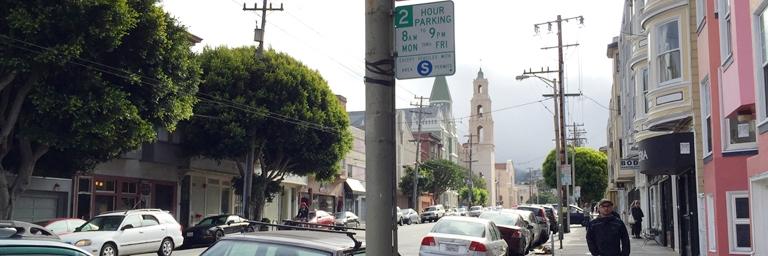The SFMTA is undertaking a comprehensive, data-driven evaluation of the Residential Parking Permit (RPP) program.
The program, which provides residents with an exemption to parking time limits in their neighborhood, has been largely unchanged for 39 years, even as San Francisco has changed considerably. The SFMTA is seeking to update the program, align it with the agency’s overall strategic goals and improve customer service for permit holders.
The evaluation effort has included data collection and analysis to reveal existing trends; a review of best practices in on-street parking management in residential areas; and robust public engagement, including a citywide survey on residential parking.
Current Project Status
The SFMTA held an Open House on May 3, 2018, at One South Van Ness, (2nd floor Atrium) to share the proposed changes to San Francisco’s Residential Parking Permit (RPP) program. This event provided an opportunity to learn more about RPP program reforms (see list below) and speak with project staff.
The list of proposed RPP Program changes to the Transportation Code are:
- No longer allow a waiver of the 4 permits per address limit
- Simplify the Transportation Code language for designating, rescinding or modifying a residential parking permit area;
- Limit the number of residential parking permits in all newly established RPP Areas:
- no more than one permit per person and no more than two permits per address
- up to 4 permits allowed if there is available on-street parking on the block
- exempt permits issued for health care or childcare workers from the 2 per household limit
- Make it easier for new parents to obtain in-home care by eliminating the petition process for an in-home care provider;
- Allow a resident licensed to operate a family child care home to obtain a permit for use by an assistant care provider working at the home; and
- Exempt a vehicle displaying a valid parking permit from payment at on-street parking meters located in the RPP area where designated with posted signs.
- Completed
Background
The San Francisco Board of Supervisors established the Residential Parking Permit program in 1976 in response to increasing commuter traffic in residential neighborhoods. The program’s goal is to protect residential neighborhoods from the spillover effects of proximity to major automobile destinations like transit stations, employment centers, tourist attractions, hospitals and colleges. To do this, parking time limits were created for non-residents.
Today, the program has grown to include 29 permit parking areas in the city.
Need for Evaluation
The city faces different challenges on the street now than when the residential permit program began, and the SFMTA recognizes it’s time to update the program to meet the needs of an evolving city.
When San Francisco established its residential parking program, the corduroy suit was in fashion, Charlie’s Angels made its television premiere and Rocky opened at the box office. A lot has changed since then, including:
- There are more cars in the city (over 500,000 cars on San Francisco’s streets every day)
- There is a growing demand for curb space all over the city, including in residential areas
- Muni Metro service was inaugurated in 1980 and now includes six lines
- The population has increased from roughly 686,000 people to more than 840,000 – all in 47 square miles, making San Francisco the second-most densely populated city in North America after New York City.
- By 2040, San Francisco is projected to add 100,000 new households and 190,000 new jobs
- San Francisco’s weekday commuter population has grown to approximately 1.3 million people
- Vehicle-sharing services like City CarShare and Scoot were invented
It’s time for the SFMTA to evaluate its residential parking permit policy to see what has worked and make suggestions for improvement.
Interim Upgrades
We have made some recent modifications to help the program evolve, like putting the petition to create a new permit area online, and easing time limit restrictions on electric two-wheeled scooters to help more people get around easily.
But the Transportation Code governing the residential parking program wasn’t designed to take into consideration the city’s population and car ownership growth, or users like small businesses or car share operators. Also, the code doesn’t address the unique parking challenge of residential development in once-industrial neighborhoods.
Comprehensive Approach
The SFMTA is exploring options for better balancing the demand for on-street parking in residential areas. Now, after nearly four decades, the SFMTA will analyze the effectiveness of its residential parking permit program. To do this, the SFMTA will conduct a comprehensive, data-driven review and gather community input.
The SFMTA is gathering data on census, land use, business, employment and other topics to better understand the effectiveness of the Residential Parking Permit program. We are conducting a survey of on-street parking conditions in neighborhoods throughout the city to gauge parking occupancy and use. We have also undertaken a household survey of San Francisco residents to learn how people utilize on-street parking and their experiences with the permit program. Public engagement will play a key role in every aspect of the evaluation, importantly including gathering input from residents, neighborhood merchants, and other stakeholders.
Major Components of the Residential Parking Permit Evaluation
- Identifying opportunities to improve customer service
- Public engagement to solicit input
- Collection and analysis of data related to existing conditions and trends
- Review of best practices in on-street parking management in residential areas
- Development and evaluation of policy options
- Policy proposals to the SFMTA Board of Directors
